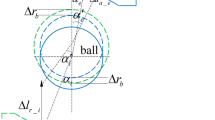Abstract
The purpose of a ball bearing is to reduce the rotational friction and support radial and axial loading. But it can’t avoid the heat generation by the friction, the wear and the power loss it was caused by the relative motion between the metal materials. Heat is generated by the friction in the bearings, which causes the temperature inside the bearing to increase. If the heat is not appropriately removed from the bearing, elevated temperatures may give rise to premature failure. It is, therefore, important to be able to calculate the temperature in the bearings due to friction. Here, we describe a method to estimate the equilibrium temperature on the angular contact ball bearing in a spindle system using a numerical approach. The frictional torque of the bearing in a spindle system was calculated by use of a bearing analysis tool and thermal analysis of the spindle system including the bearings was achieved using the finite element method (FEM). The actual spindle system with the same layout of the FEA was built and the frictional torque, the bearing temperature were measured in the experiment. The bearing temperature was compared with measured data to verify the validity of finite element analysis.
Similar content being viewed by others
Abbreviations
- A :
-
Area (mm2)
- d M :
-
Bearing pitch diameter (mm)
- F a , F r :
-
Applied axial and radial loads (N)
- F 0a , F 0r :
-
Axial and radial static bearing loads (N)
- f 0 :
-
Factor depends on the bearing lubrication type
- f 1 :
-
Factor which is a function of the preload
- h :
-
Conductance (W/m2K)
- L :
-
Characteristic length (mm)
- M 1 :
-
Bearing frictional torque due to load (Nm)
- M 0 :
-
Bearing frictional torque due to lubrication (Nm)
- M R :
-
Bearing frictional torque (Nm)
- N R :
-
Frictional power loss (W)
- Nu :
-
Nusselt number
- n :
-
Rotational speed (rpm)
- P 1 :
-
Equivalent load depends on the value and direction of the load (N)
- \(\dot Q\) :
-
Heat dissipation rate (W)
- α :
-
Heat transfer coefficient (W/m2K)
- δ :
-
Gap width (mm)
- v :
-
kinematic viscosity of the lubricant (mm2/s)
- λ :
-
Thermal conductivity of air (W/mK)
- λ F :
-
Thermal conductivity of the fluid (W/mK)
- Δθ :
-
Temperature difference between the surface and the fluid (K)
References
Harris, T. A. and Barnsby, R. M., “Tribological Performance Prediction of Aircraft Gas Turbine Mainshaft Ball Bearings,” Tribology Transactions, Vol. 41, No. 1, pp. 60–68, 1998.
Zverev, I. A., Eun, I.-U., Hwang, Y.-K., Chung, W. J., and Lee, C. M., “An Elastic Deformation Model of High-Speed Spindle Units,” Int. J. Precis. Eng. Manuf., Vol. 7, No. 3, pp. 39–46, 2006.
Brändlein, J., Eschmann, P., Hasbargen, L., and Weigand, K., “Ball and Roller Bearings: Theory, Design, and Application,” Wiley Chichester, pp. 228–260, 1999.
Houpert, L., “Ball Bearing and Tapered Roller Bearing Torque: Analytical, Numerical and Experimental Results,” Tribology Transactions, Vol. 45, No. 3, pp. 345–353, 2002.
Bossmanns, B. and Tu, J. F., “A Thermal Model for High Speed Motorized Spindles,” International Journal of Machine Tools and Manufacture, Vol. 39, No. 9, pp. 1345–1366, 1999.
Bossmanns, B. and Tu, J. F., “A Power Flow Model for High Speed Motorized Spindles—Heat Generation Characterization,” Journal of Manufacturing Science and Engineering, Vol. 123, No. 3, pp. 494–505, 2001.
Lin, C.-W., Tu, J. F., and Kamman, J., “An Integrated Thermo-Mechanical-Dynamic Model to Characterize Motorized Machine Tool Spindles during very High Speed Rotation,” International Journal of Machine Tools and Manufacture, Vol. 43, No. 10, pp. 1035–1050, 2003.
Li, H. and Shin, Y. C., “Integrated Dynamic Thermo-Mechanical Modeling of High Speed Spindles, Part 1: Model Development,” Journal of Manufacturing Science and Engineering, Vol. 126, No. 1, pp. 148–158, 2004.
Li, H. and Shin, Y. C., “Analysis of Bearing Configuration Effects on High Speed Spindles using an Integrated Dynamic Thermo- Mechanical Spindle Model,” International Journal of Machine Tools and Manufacture, Vol. 44, No. 4, pp. 347–364, 2004.
Kim, S.-M. and Lee, S.-K., “Prediction of Thermo-Elastic Behavior in a Spindle–Bearing System Considering Bearing Surroundings,” International Journal of Machine Tools and Manufacture, Vol. 41, No. 6, pp. 809–831, 2001.
Min, X., Shuyun, J., and Ying, C., “An Improved Thermal Model for Machine Tool Bearings,” International Journal of Machine Tools and Manufacture, Vol. 47, No. 1, pp. 53–62, 2007.
Schaeffler Technologies GmbH & Co. KG, “Bearinx-online Easy Friction: Detailed Friction Calculations for Rolling Bearing,” 2011.
Harris, T. A. and Kotzalas, M. N., “Advanced Concepts of Bearing Technology,: Rolling Bearing Analysis,” Taylor & Francis, 5th Ed., pp. 191–208, 2006.
Harris, T. A. and Kotzalas, M. N., “Essential Concepts of Bearing Technology,” Taylor & Francis, 5th Ed., pp. 184–192, 2007.
Udup, E., Bisu, C.-F., and Zapciu, M., “Numerical Model for Thermo-Mechanical Spindle Behavior,” Advances in Production, Automation and Transportation Systems, Vol. 48, pp. 259–264, 2013.
Cardone, G., Astarita, T., and Carlomagno, G., “Infrared Heat Transfer Measurements on a Rotating Disk,” Optical Diagnostics in Engineering, Vol. 1, No. 2, pp. 1–7, 1996.
Dropkin, D. and Carmi, A., “Natural Convection Heat Transfer from a Horizontal Cylinder Rotating in Air,” Transantions of the ASME, Vol. 79, No. 5, pp. 741–749, 1957.
Author information
Authors and Affiliations
Corresponding author
Rights and permissions
About this article
Cite this article
Kim, KS., Lee, DW., Lee, SM. et al. A numerical approach to determine the frictional torque and temperature of an angular contact ball bearing in a spindle system. Int. J. Precis. Eng. Manuf. 16, 135–142 (2015). https://doi.org/10.1007/s12541-015-0017-1
Received:
Revised:
Accepted:
Published:
Issue Date:
DOI: https://doi.org/10.1007/s12541-015-0017-1



